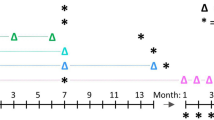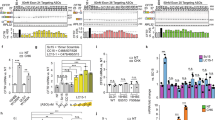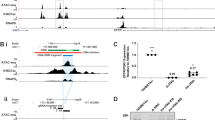Abstract
For effective gene therapy of chronic disease, persistent transgene expression at therapeutic levels is required. Clinical studies of airway gene transfer in patients with cystic fibrosis (CF) have resulted in short-lived transgene expression. We used intra-nasal dosing of naked plasmid DNA to the murine lung as a model for investigating the duration of airway gene transfer from a series of reporter expression plasmids. Transgene expression was transient when mediated by the viral promoters CMV, RSV and SV40, falling to less than 10% of peak expression after 2 weeks, although the presence of the adenoviral E4ORF3 gene in cis, resulted in extended duration of reporter activity from the CMV promoter. Transient expression from these promoters was not due to loss of the vector as determined by quantitative TaqMan PCR analysis. However, use of the promoters from the human polybiquitin C (UbC) and the elongation factor 1α (EF1α) genes resulted in persistent gene expression in the mouse lung. The UbC promoter directed high-level reporter activity which was maintained for up to 8 weeks and was still detectable 6 months after a single administration. Such persistent airway transgene expression from a nonviral vector without the concomitant expression of a potential antigen has not been reported previously. Thus, despite the persistence of vector DNA in vivo, attenuation of promoter function may lead to silencing of transgene expression and careful selection of promoter sequences is recommended for in vivo gene transfer.
This is a preview of subscription content, access via your institution
Access options
Subscribe to this journal
Receive 12 print issues and online access
$259.00 per year
only $21.58 per issue
Buy this article
- Purchase on Springer Link
- Instant access to full article PDF
Prices may be subject to local taxes which are calculated during checkout







Similar content being viewed by others
References
Gill DR et al. A placebo-controlled study of liposome-mediated gene transfer to the nasal epithelium of patients with cystic fibrosis Gene Therapy 1997 4: 199–209
Hyde SC et al. Repeat administration of DNA/liposomes to the nasal epithelium of patients with cystic fibrosis Gene Therapy 2000 7: 1156–1165
Alton EWFW et al. Towards gene therapy for cystic fibrosis: a clinical progress report Gene Therapy 1998 5: 291–292
Lee ER et al. Detailed analysis of structures and formulations of cationic lipids for efficient gene transfer to the lung Hum Gene Ther 1996 7: 1701–1717
Yew NS et al. Optimization of plasmid vectors for high-level expression in lung epithelial cells Hum Gene Ther 1997 8: 575–584
Hillery E, Cheng SH, Geddes DM, Alton EWFW . Effects of altering dosing on cationic liposome-mediated gene transfer to the respiratory epithelium Gene Therapy 1999 6: 1313–1316
Baskar JF et al. The enhancer domain of the human cytomegalovirus major immediate–early promoter determines cell-type specific expression in transgenic mice J Virol 1996 70: 3207–3214
Loser P, Jennings GS, Strauss M, Sandig V . Reactivation of the previously silenced cytomegalovirus major immediate–early promoter in the mouse liver: involvement of NfkappaB J Virol 1998 72: 180–190
Armentano D et al. Effect of the E4 region on the persistence of transgene expression from adenovirus vectors J Virol 1997 71: 2408–2416
Brough DE et al. Activation of transgene expression by early region 4 is responsible for a high level of persistent transgene expression from adenovirus vectors in vivo J Virol 1997 71: 9206–9213
Yew NS et al. Increased duration of transgene expression in the lung with plasmd DNA vectors harboring adenovirus E4 open reading frame 3 Hum Gene Ther 1999 10: 1833–1843
Uetsuki T et al. Isolation and characterization of the human chromosomal gene for polypeptide chain elongation factor-1 alpha J Biol Chem 1989 264: 5791–5798
Nenoi M et al. Heterogeneous structure of the polyubiquitin gene UbC of HeLa S3 cells Gene 1996 175: 179–185
Chen Z-Y et al. Linear DNAs concatemerise in vivo and result in sustained transgene expression in mouse liver Mol Ther 2001 3: 403–410
Paillard F . Promoter attenuation in gene therapy: causes and remedies Hum Gene Ther 1997 8: 2009–2010
Qin L et al. Promoter attenuation in gene therapy: interferon γ and tumour necrosis factor-α inhibit transgene expression Hum Gene Ther 1997 8: 2019–2029
Kuriyama S et al. Expression of a retrovirally transduced gene under control of an internal housekeeping gene promoter does not persist due to methylation and is restored partially by 5-azacytidine treatment Gene Therapy 1998 5: 1299–1305
Laegreid A et al. Tumor necrosis factor receptor p75 mediates cell-specific activation of nuclear factor kappa B and induction of human cytomegalovirus enhancer J Biol Chem 1994 11; 269: 7785–7791
Sung RS, Qin L, Bromberg, JS . TNFα and IFNγ induced by innate anti-adenoviral immune responses inhibit adenovirus-mediated transgene expression Mol Ther 2001 (in press)
Krieg AM, Kline JN . Immune effects and therapeutic applications of CpG motifs in bacterial DNA Immunopharmacology 2000 48: 303–305
Freimark BD et al. Cationic lipids enhance cytokine and cell influx levels in the lung following administration of plasmid: cationic lipid complexes J Immunol 1998 160: 4580–4586
Yew NS et al. Reduced inflammatory response to plasmid DNA vectors by elimination and inhibition of immunostimulatory CpG motifs Mol Ther 2000 1: 255–262
Carvalho T et al. Targeting of Adnovirus E1A and E4-ORF3 proteins to the nuclear matrix PML bodies J Cell Biol 1995 131: 45–56
Bestor TH . Gene silencing as a threat to the success of gene therapy J Clin Invest 2000 105: 409–411
Paszkowski J, Whitman SA . Gene silencing and DNA methylation processes Curr Opin Plant Biol 2001 4: 123–129
Spencer VA, Davie JR . Role of covalent modifications of histones in regulating gene expression Gene 1999 240: 1–12
Newell-Price J, Clark AJL, King P . DNA methylation and silencing of gene expression Trends Endocrinol Metabol 2000 11: 142–148
Schorpp M et al. The human ubiquitin C promoter directs high ubiquitous expression of transgenes in mice Nucleic Acids Res 1996 24: 1787–1788
Kozak M . Point mutations define a sequence flanking the AUG initiator codon that modulates translation by eukaryotic ribosomes Cell 1986 44: 283–292
Herisse J et al. Nucleotide sequence of adenovirus 2 DNA fragment encoding the carboxylic region of the fiber protein and the entire E4 region Nucleic Acids Res 1981 9: 4023–4042
Roberts RJ et al. A consensus sequence for the adenovirus-2 genome. In: Doerfler W (ed.) Adenovirus DNA: The Viral Genome and its Expression vol 8: Nijhoff: Boston 1986 pp 1–52
Graham FL, Smiley J, Russell WC, Nairn R . Characterisation of a human cell line transformed by DNA from human adenovirus type 5 J Gen Virol 1977 36: 59–72
Gao X, Huang L . A novel cationic liposome reagent for efficient transfection of mammalian cells Biochem Biophys Res Commun 1991 179: 280–285
Acknowledgements
The authors thank Gary Ketner for the kind gift of anti-E4 ORF3 antibody and Brian Seed for plasmid πH3-CD8. The study was funded by the Cystic Fibrosis Trust (UK), Medical Research Council (UK), the Wellcome Trust and the National Lottery Fund.
Author information
Authors and Affiliations
Rights and permissions
About this article
Cite this article
Gill, D., Smyth, S., Goddard, C. et al. Increased persistence of lung gene expression using plasmids containing the ubiquitin C or elongation factor1α promoter. Gene Ther 8, 1539–1546 (2001). https://doi.org/10.1038/sj.gt.3301561
Received:
Accepted:
Published:
Issue Date:
DOI: https://doi.org/10.1038/sj.gt.3301561
Keywords
This article is cited by
-
Allele specific repair of splicing mutations in cystic fibrosis through AsCas12a genome editing
Nature Communications (2019)
-
The murine lung as a factory to produce secreted intrapulmonary and circulatory proteins
Gene Therapy (2018)
-
Minicircle DNA Provides Enhanced and Prolonged Transgene Expression Following Airway Gene Transfer
Scientific Reports (2016)
-
Impact of Using Different Promoters and Matrix Attachment Regions on Recombinant Protein Expression Level and Stability in Stably Transfected CHO Cells
Molecular Biotechnology (2015)
-
Non-viral vectors for gene-based therapy
Nature Reviews Genetics (2014)



